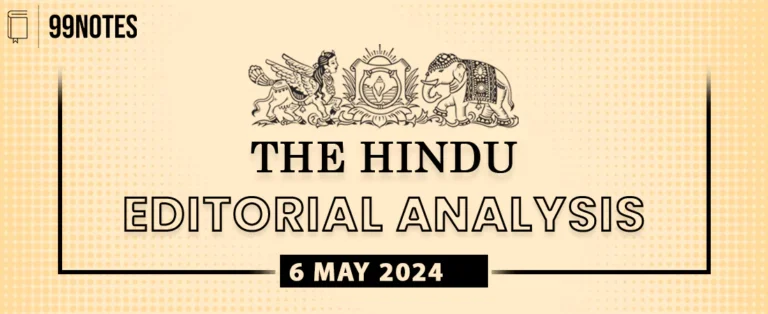5 March 2024 : The Hindu Editorial Notes PDF
The Hindu Editorial
5-March-2024
1. World Trade Organization continues to struggle to foster free and fair trade
| Topic: GS2 – International Relations – Important International institutions, agencies and fora UPSC Relevance: The article sheds light on challenges at the WTO’s MC13, crucial for understanding global trade dynamics and diplomatic complexities. |
| Context |
|
WTO’s 13th Ministerial Conference (MC13): Lack of Progress
- Challenges despite Extension: The recent meeting of the World Trade Organization’s (WTO) MC13 concluded with minimal progress on critical global trade issues, despite extending deliberations by a day.
- Low Expectations: Anticipations for substantial outcomes were initially low, but the conference represented a crucial moment for the WTO to fulfill its mandate amid a challenging global trade environment.
Global Trade Challenges: Shocks and Shifts
- Global Shocks: Recent global shocks, including conflicts, disruptions in critical shipment routes, and supply chain recalibrations, have impacted the world’s trading architecture.
- Inward-Looking Policies: An increasing trend of nations adopting inward-looking, tariff-heavy trade policies has diverged from the WTO’s core purpose of fostering open trade for mutual benefit.
MC13 Declaration and Challenges Ahead
- Abu Dhabi Declaration: The Abu Dhabi declaration acknowledges challenges such as the need for resilient supply chains but lacks substantive measures beyond rhetorical commitments.
- Persistent Divergences: Disagreements persist among the WTO’s 164 member-countries on issues carried forward from Geneva, particularly concerning India, such as a permanent solution for agricultural public stock holding.
Key Developments and Concerns
- Agricultural Progress: Agriculture deliberations, ongoing for over two decades, have seen some progress, with a text now available for future negotiations.
- E-commerce Customs Duties: The exemption from customs duties for e-commerce, opposed by India, continues for at least two more years, with India expressing conditional flexibility.
- Dispute Resolution: Prospects for reviving WTO’s dispute resolution body, dormant for four years, seem bleak, despite the commitment to revive it by 2024.
- India’s Success: India successfully collaborated with South Africa to thwart a China-led attempt to introduce an investment facilitation pact into the WTO framework.
Challenges Ahead and WTO’s Relevance
- Policy Space for Sensitive Sectors: India must intensify efforts to protect policy space for sensitive sectors, especially agriculture.
- WTO’s Relevance: The WTO faces challenges in staying relevant amid an increasingly polarized world, with member countries often portraying failed meetings as successes, indicating diminishing efficacy.
Conclusion
- In conclusion, the WTO’s 13th Ministerial Conference exposes the urgency of addressing global trade challenges amidst divergent national interests.
- The limited progress highlights the imperative for comprehensive reforms to bolster the WTO’s effectiveness and ensure its continued relevance in shaping international trade dynamics.
| Challenges faced by WTO and Need for Reforms |
Challenges faced by WTO in recent times:
Need for Reforms:
|
| PYQ: What are the key areas of reform if the WTO has to survive in the present context of ‘Trade War’, especially keeping in mind the interest of India? (250 words/15m) (UPSC CSE (M) GS-2 2018) |
| Practice Question: In the context of contemporary challenges faced by the World Trade Organization (WTO), discuss the imperative for reforms in the organization. Highlight key areas requiring attention and propose measures to enhance the WTO’s effectiveness in addressing evolving global trade dynamics. (250 words/15 m) |
2. A vaccine that prevents six cancers
| Topic: GS2 – Social Justice – Health, GS3 – Science and Technology This article highlights crucial healthcare challenges, vaccination strategies, and physician advocacy efforts, relevant for UPSC’s health-related questions. |
| Context |
|
Introduction:
- January is observed as Cervical Cancer Awareness Month, and March 4 is International HPV Awareness Day.
- Cervical cancer is the fourth most common cancer among women globally, claiming over 300,000 lives annually.
- In India, it is the second most common cancer, and with the current population size, around 500 million women above 15 are at risk.
Alarming Statistics:
- Globally, cervical cancer claims one life every two minutes, with 90% of deaths occurring in lower- and middle-income countries.
- India’s projected increase in cervical cancer cases by 54% in 2040 highlights the urgency of preventive measures.
Strategies for Prevention:
- German scientist Harald zur Hausen’s 1983 discovery linked cervical cancer to certain papillomaviruses (HPV).
- Two key prevention strategies emerged: HPV vaccination and screening for precancerous lesions.
- The World Health Organization’s 90-70-90 triple pillar intervention aims for elimination by 2030.
WHO’s Triple Pillar Intervention:
- By 2030, 90% of girls should be fully vaccinated by age 15, 70% of women screened by 35 and 45, and 90% of detected cases receiving treatment.
- High-quality and equitable healthcare services are integral to the intervention’s success.
India’s Commitment and Challenges:
- India’s G20 presidency commits to equitable vaccine access, with the HPV vaccine introduced in 2008.
- Despite successful roll-outs, the vaccine awaits a national launch, facing accessibility challenges and cost barriers.
Physician Hesitation and Public Perception:
- Research indicates limited accessibility to the HPV vaccine in India, primarily due to out-of-pocket costs in the private market.
- Physicians may underestimate the incidence and risks of cervical cancer, as well as the safety and effectiveness of HPV vaccines.
- Hesitation may stem from concerns about intimate transmission and addressing parental myths and misinformation.
FOGSI and IAP Initiative:
- Federation of Obstetric and Gynaecological Societies of India (FOGSI) and Indian Academy of Pediatrics (IAP) join forces.
- With over 80,000 combined members, they aim to educate physicians and bridge the communication gap with parents.
Physician Leadership and Advocacy:
- Physicians are positioned as respected leaders and trusted sources for health-related information.
- FOGSI and IAP are working to create 20,000 HPV physician champions by mid-2024 to advocate for HPV vaccination.
Facts and Best Practices:
- HPV vaccination is safe and effective, preventing six HPV-related cancers, five of which affect women.
- IAP recommends initiating HPV vaccination at age 9, reinforcing the importance of completing the immunization schedule.
Conclusion:
- Physicians play a pivotal role in eliminating cervical cancer in India.
- FOGSI and IAP’s initiative seeks to ensure every girl is protected through HPV vaccination and every woman through regular screening.
- With the support of physician champions, public awareness and acceptance of HPV vaccination are expected to rise, contributing to the goal of cervical cancer elimination in India.
| PYQ: In the context of vaccines manufactured to prevent COVID-19 pandemic, consider the following statements: (2022) 1. The Serum Institute of India produced COVID-19 vaccine named Covishield using mRNA platform. 2. Sputnik V vaccine is manufactured using vector based platform. 3. COVAXIN is an inactivated pathogen based vaccine. Which of the statements given above are correct? (a) 1 and 2 only (b) 2 and 3 only (c) 1 and 3 only (d) 1, 2 and 3 Ans: (b) |
| Practice Question: Examine the global and national efforts towards cervical cancer elimination, analyzing the significance of WHO’s intervention goals and the role of physician leadership in India. (150 words/10 m) |
For Enquiry

5 March 2024 : Daily Current Affairs

5 March 2024 : Indian Express Editorial Analysis

5 March 2024 : PIB Summary for UPSC

5 March 2024 : The Hindu Editorial Notes PDF

Civil Disobedience Movement: Cause, Limitations, And Impact

Yojana Summary: January 2024 – Ease Of Doing Business

4 Mar 2024 : Daily Answer Writing

4 March 2024 : Daily Current Affairs

4 March 2024 : The Hindu Editorial Notes PDF

4 March 2024 : PIB Summary for UPSC
Daily Current Affairs 5 March 2024 : Daily Current Affairs Daily Current Affairs
5-March -2024- Top News of the Day
1. Supreme Court Challenges Parliamentary Privilege:…
Indian Express 5 March 2024 : Indian Express Editorial Analysis Indian Express Editorial Analysis
5-March-2024
1. Let Pakistan be
Topic: GS2 – International Relations…
March 2024 PIB 5 March 2024 : PIB Summary for UPSC PIB Summary for UPSC
5-March -2024
1. DefConnect 2024: Raksha Mantri launches ADITI scheme to promote…
March – The Hindu Editorial 5 March 2024 : The Hindu Editorial Notes PDF The Hindu Editorial
5-March-2024
1. World Trade Organization continues to struggle to foster free and…
general studies 1 Civil Disobedience Movement: Cause, Limitations, And Impact Civil Disobedience Movements:
Civil Disobedience Movement, one of the most pivotal episodes in India’s…
Yojana Summary Yojana Summary: January 2024 – Ease Of Doing Business Yojana Magazine Summary January 2024
Yojana magazine is monthly magazine published by government of India’s…
mains answer writing 4 Mar 2024 : Daily Answer Writing Mains Answer Writing
4-March-2024
Q1) “The Attorney General of India holds a pivotal position…
Daily Current Affairs 4 March 2024 : Daily Current Affairs Daily Current Affairs
4-March -2024- Top News of the Day
1. India’s Household Expenditure Survey…
March – The Hindu Editorial 4 March 2024 : The Hindu Editorial Notes PDF The Hindu Editorial
4-March-2024
1. Mountains of plastic are choking the Himalayan States
Topic:…
March 2024 PIB 4 March 2024 : PIB Summary for UPSC PIB Summary for UPSC
4-March -2024
1. The Union Ministry of Home Affairs releases three videos about…




